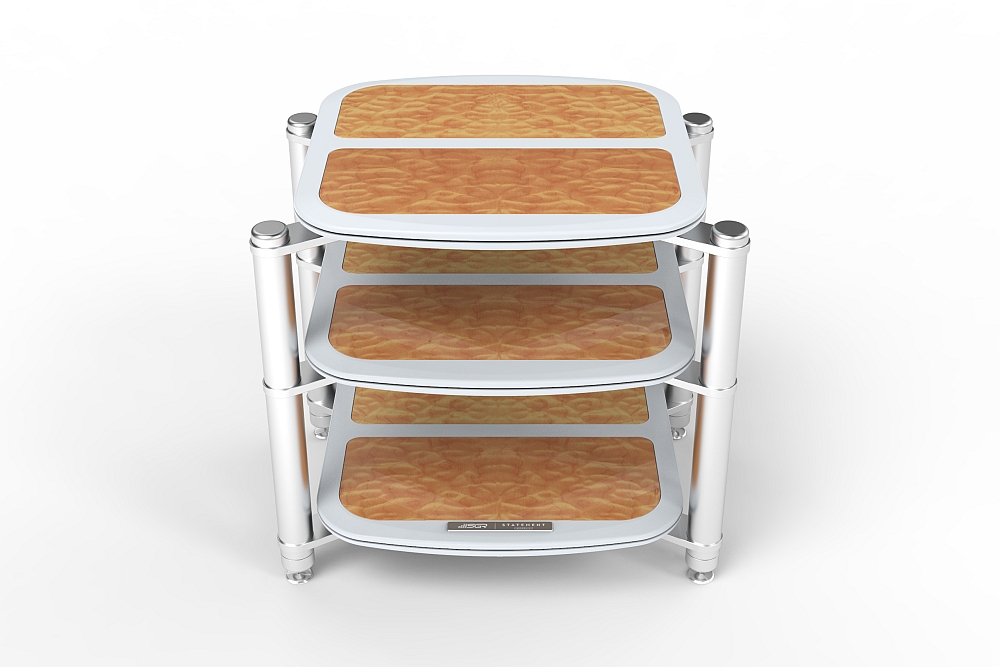The audio ‘limelight’ is, by and large, monopolised by the often outrageous industrial designs of components flashing chrome and gold plating, sporting sharply styled (and edged) heatsink metalwork or by those exuding the warm seduction of glowing glass. The less glamorous racking system which, critically, provides support to the various audio apparatus, is often naively seen as a secondary player. However, a high quality Hi-Fi equipment rack is of extreme importance within the context of a well-sorted high-end audio system. If solidly-engineered, an audio rack can provide discernable sonic gains by isolating and/or coupling your expensive electronics allowing the expression of their full potential. Here, in the flagship SGR Audio Model V Statement, I examine one of the very best in terms of technical design, build quality, finish options and, most importantly, its facilitation and communication of music.
Full Support
The SGR Hi-Fi equipment racks are modular designs available in a number of ‘Styles’ with varying degrees of isolation, support systems, design and finish options. The Model V Statement reviewed here is the company’s all-out effort to create the best possible racking system for your Hi-Fi. The company now offers a number of Hi-Fi equipment rack options with the entry point being the Model I which, despite being an introduction, clearly illustrates SGR Audio’s fabrication skills – it’s a solidly made basic rack with CNC-machined metal parts and quality fittings. From there the range progresses to the Model III which is available in two ‘Styles’ with differing isolation schemes and then the rack systems top-out at the Model V. The Model V is offered in three ‘Styles’ – the Statement being the zenith – again with variations in isolation techniques.
The Model V Statement arrived in six individual boxes for the configuration needed to accommodate my system which is a dual rack/three shelf arrangement. The packaging has been cleverly designed to house in protective hard foam a platform, support and isolation system for a single level, which is also the method SGR Audio uses to price the racks (from AU$795 per level for the entry-point Model I to several price points in between and culminating in the Model V Statement’s AU$4200 per level). The box containing the rack’s bottom level contains the additional items required, which can be either a ‘Ball race’ levelling footer system or heavy duty coupling spikes. The inserts for the platforms, or shelves, can be ordered in a number of beautiful, quality wood veneer options and SGR Audio can cater for custom platform sizes (including large top platforms dedicated to supporting hefty turntable systems). On the inserts; they’re not just pretty styling enhancements but serve a definite purpose as you’ll read below. The posts’ dimensions, therefore the distance between the shelves, are available in a number of clearance heights.
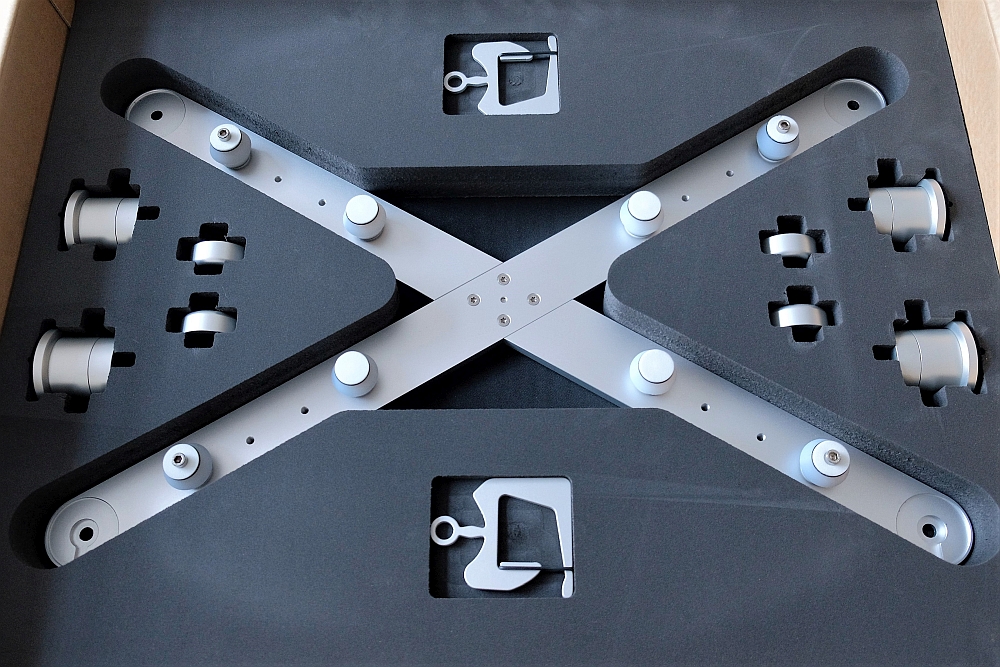
The story around the Statement is rather interesting too. SGR Audio’s CEO and Chief Designer Stuart Ralston is a talented engineer with a relentless eye for detail (evidence of his skills are ample in the company’s superb active and passive speaker systems and amplifiers). In his quest to present a product that is world-class he examined and evaluated every aspect of the rack designs but, in terms of the metalwork, he originally sought the services of high quality local contractors for some of the aluminium machining and finishing. As good as these companies were, they did not entirely satisfy Ralston’s quest for finish perfection.
So, over a two year period, Ralston acquired the machines and developed the skills and processes required to produce aluminium in the silky-smooth finish texture he demanded. Over a considerable time and after many trial and error campaigns, Ralston perfected the cosmetic quality that is now used on SGR Audio’s latest-gen racks. The Statement racking systems’ build quality and aluminium finish is on par with the highest standards I’ve seen. It really is of the ilk of the best CNC machine work which is featured in the massive front panels on products from Ypsilon, Goldmund, Vitus, etc.
I asked Ralston for me some details on how he went about perfecting the finish quality, any special machinery or methods he had to adopt, etc.
One of the biggest hurdles faced in manufacturing components out of aluminium is surface finishing. All our aluminium parts are produced by a CNC machining process, either by mill or lathe. Raw parts straight from the CNC always show ‘machine marks’, and to supply a finished component worthy of the high-end tag we need to remove these marks and present a flawless and immaculate finish. The most common technique to do this is called ‘bead-blasting’, where glass beads are blown at high pressure towards the raw aluminium component and the machine marks on the surface are effectively blasted away, leaving a very consistent, tiny dimple-type texture. The bigger the beads, the larger the dimples and the easier it is to remove deep machine marks. We use a very fine ‘micro’ bead, which means our CNC machining has to be highly optimised as these fine beads only remove very light surface scratches. The result of using such fine beads creates a texture with seemingly pearlescent lustre, hence the term we adopted for this delicate finish, ‘micro-pearl’.
The problem with bead-blasting aluminium is that it changes the surface of the aluminium, and it becomes very non-conducive to anodising. Depending on the pressure used during the blasting process it can create a range of ugly side-effects to the anodising process ranging from a dull and/or spotty colour to a chalky and unpleasant feel. I found this out the hard way. I spent six months working with local anodising companies, trying to optimise both their process and ours, and whilst we made improvements, the result was, admittedly, rather average. The fundamental issue became apparent, the market for anodising in Australia is mostly for corrosion-resistance, with decorative anodising being so uncommon that local anodisers had little experience and could not offer a great deal of advice. So I was on my own, and the research began.
I could really drag this story out, as it was quite a journey, but long story short I perfected our ‘micro-pearl’ finish by implementing a pre-processing step before anodising called ‘electro-polishing’, which as the name would suggest uses an electric current to polish the surface of the aluminium. After research led me to conclude that electro-polishing was the solution, I called multiple suppliers and found absolutely no-one in Australia was electro-polishing aluminium. A handful were electro-polishing stainless steel. They all told me there is no market for it here, and it's very difficult.
"Difficult" has never perturbed me, so I built a seven station electro-polishing line, complete with all the pre- and post-processing chemical tanks, driven by a 12,000W capable power supply. With very little information available online, and no-one to call locally for advice I put countless hours into trial and error (a lot of error!) over a 12 month period before ironing out all the intricate details of the process and achieving the flawless finish I was looking for. The final process involves 13 important steps, all conducted with high tolerance. The variables for each process have been slightly tweaked over the last few years to the point where I would say the finish is now perfected. But from prototype to perfection took three years. I must admit, it really was difficult, but it was definitely worth it as we can now produce a finish equal to the best in the world.
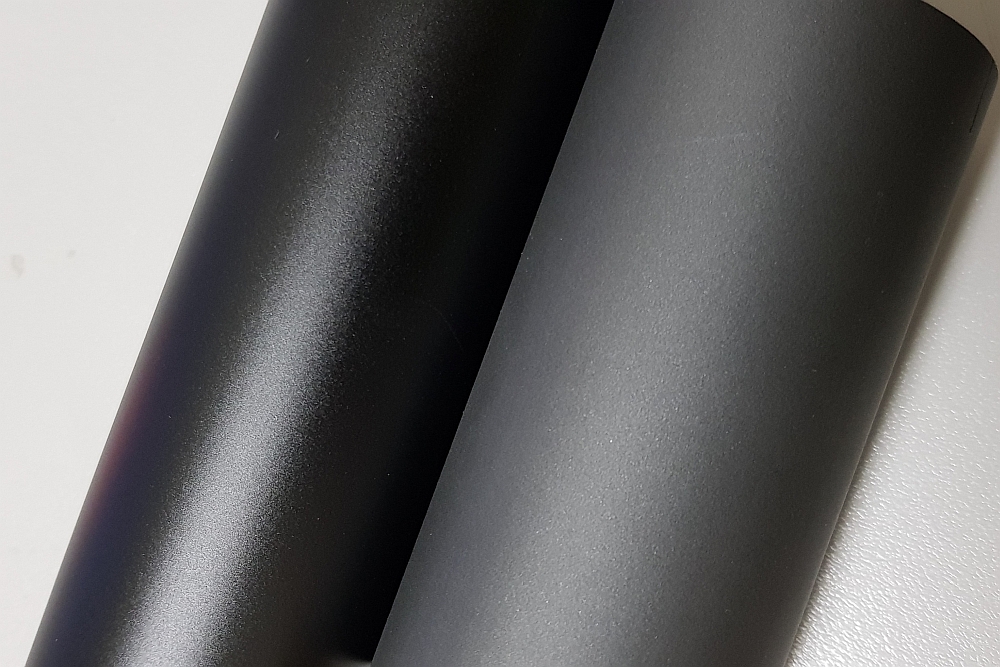 The grey sample feels chalky, is supposed to be black and, after six months of collaboration, was the best result local companies could produce. The black sample feels smooth and is a consistent dark jet-black (sample from recent production batch).
The grey sample feels chalky, is supposed to be black and, after six months of collaboration, was the best result local companies could produce. The black sample feels smooth and is a consistent dark jet-black (sample from recent production batch).
So, while the metalwork/framework for the Statement is extremely well fabricated and finished, the same can be said for the support platforms, or shelves. In the case of the Statement, each platform is a sandwich of constrained layer-damped materials and polymer inserts engineered to provide as stable a base for your electronics as possible. An exclusive for the Model V Statement system are CNC-machined Corian “Energy Sink Isolation Pads” which provide further isolation and can be veneered in a number of beautiful real wood finishes. Both the framework and platforms are available in black or natural finish options.
I asked what materials are used between the shelf layers. Are there proprietary materials/techniques involved?
It's a specialised extruded polymer with zero PVC plasticisers, which means it can long-term bond to adhesives. Many similar damping products on the market will not bond long-term, causing items to basically fall apart over time! Our material has high transmission loss and internal loss factor, creating a very effective noise reduction solution.
So, let’s summarise the isolation techniques – totalling six methods – that have been implemented in the Model V Statement.

From the ground up there’s the choice of ‘Ball Racer’ or precision-milled heavy duty spiking systems. The framework’s posts are filled with crushed quartz in order to provide a heavy non-resonant and damped tubing system. Then, you have the solid aluminium CNC-machined cross-bracing which can support up to 100kg (conservatively). The cross-brace system can accept strategically-placed visco-elastic silicon isolators (read about their adoption on the previous series of SGR Audio racks here) which can be used in a variety of groupings to cater for differing components’ weight and centre of gravity. The constrained-layer damped wood composite platforms feature a sandwiched polymer insert and then, finally, the abovementioned CNC-machined Corian “Energy Sink Isolation Pads”. That’s the sum of all things… and right there, are the ingredients for a thoroughly engineered and superbly fabricated audio equipment racking system.
Given the engineering efforts made, did you develop a measurements suite for the racks and did that correlate with your listening tests?
We did. Similar to how we measure cabinet vibration in a loudspeaker, although rack measurements are mostly done by comparison as opposed to absolute. A transducer is used to excite the structure and accelerometers are attached at different points on the rack. When we moved, years ago, from using sorbothane to our in-house built MK2 isolators, our measurement techniques proved invaluable during development. Our final design for the MK2 isolator measures 6dB more effective at isolating bass and mid frequencies, which correlates highly with most of the feedback we receive. A recent customer even commented that he is hearing what sounds like an extra octave of bass in his system!
A final quality ’touch’. The top shelf features a metal badge stencilled with the company logo and product name. A few weeks into production, Ralston designed a more attractive metal badge which now also adopts a serial numbering system (two Allen-head bolts grip the badge from underneath the platform so they are effectively invisible). Further evidence of thorough attention to detail. Changing the badges is a simple two minute exercise. Of interest: the badges showed Serial Number #001 for the units I received – super cool.
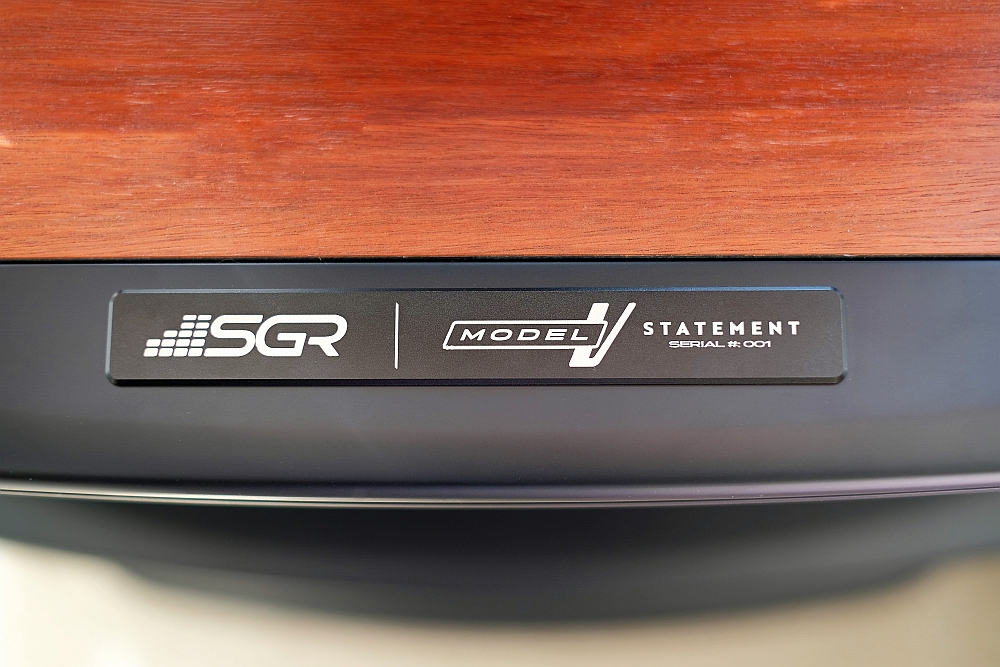
The Model V Statement is supplied with machined metal cable ‘hooks’ which come in handy in terms of guiding what can sometimes be complex cable looms. A provided thick and tight rubber ‘band’ can be used to secure the guided cables in order to prevent them from slipping out and potentially causing havoc.
Ralston had some final comments:
Apart from some of the raw materials (aluminium, paint, etc.), all components are manufactured in-house. This allows us to rapidly go from concept to production and also allows manufacturing to constantly improve. We've set the bar pretty high with our quality control, so it's hard to improve much these days in that area but we're constantly thinking of ways to improve efficiency both in terms of time and material usage. Our biggest issue at the moment seems to be keeping up with demand.
In closing, I think the saying "the difference is in the details" really applies to our hi-fi racks. By removing the interference effects caused by extraneous vibration, the details in the music shine through. But this saying also relates to the products in terms of precision machining, immaculate finishes, and presentation. A lot of effort goes into in-house manufacturing and we use high quality materials where necessary, even in our packaging inserts which are CNC routed from Australian made Polyethelene foam, costing 1.5 times that of imported alternatives and a far superior material. It's a daunting fact that it is possible to buy imported “hi-fi racks” for less than the raw manufacturing cost of one of our Model V packaging inserts. But this is high-end and demands attention to detail… all the details.
Finally, at the risk of repeating myself, I’ll mention this yet again before getting on to the sonic findings portion of the review. The Model V Statement audio equipment rack is superbly finished and is at the same level of the very best available. The veneer inserts are precision-cut and beautiful. All the more impressive is that as much of the fabrication as possible is performed in-house. Very few Australian audio companies are able to perform that most demanding of feats and, as far as the aluminium finishing work, perhaps none can. Kudos SGR Audio.
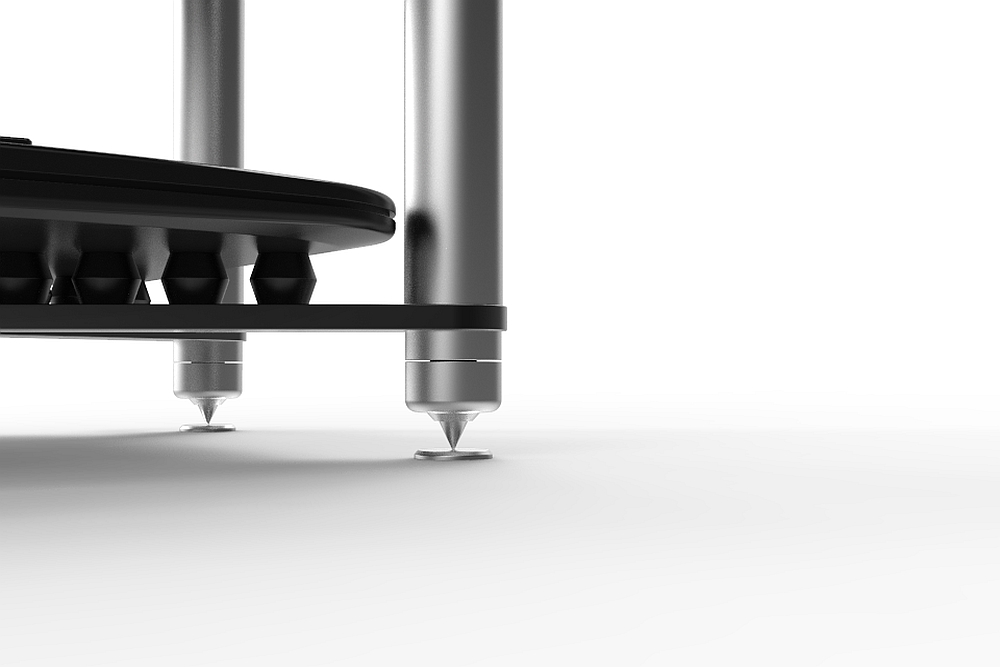
In Isolation
Assembling the racks is a simple enough process. Things just stack and fit onto each other with precision. A full three-level rack should not take more than 15 minutes to fully assemble. I had the two racks setup within an hour after futzing around taking pictures.
You start with the bottom unit which provides for the attachment of either the spiking or ball racer systems. The viscoelastic isolators simply screw into the cross-brace supports with the number used depending on the weight of the component to be supported. Then, a protruding bolt atop the isolators’ head registers with indents into the bottom of the platform which then, of course, sits precisely atop the isolators. Additional isolators can be purchased from SGR Audio at any time. The attention to detail is evident yet again – the isolators’ top and bottom surfaces, which make contact with the shelf and metalwork, are actually lined with a thin layer of doping material, providing a modicum of further isolation from vibrational distortions and preventing the contact surfaces from being blemished by silicon oils.
Despite confounding ongoing polarised belief, it is my opinion that cable variety can make anything between very subtle to substantial differences to the sound performance of high quality components. The reasons may be varied, based on either electrical or mechanical reasons, or whatever. I raise this because in the hierarchy of aspects of audio that contribute to performance variations I consider the room and the speakers to be of utmost importance, followed by electronics, then the cables and finally the ‘tweaks’ category which can include isolation cones and a variety of support ‘feet’, AC filtering, etc. While serving practical duties and neatly supporting your equipment, audio racks could be said to fall under that last category.
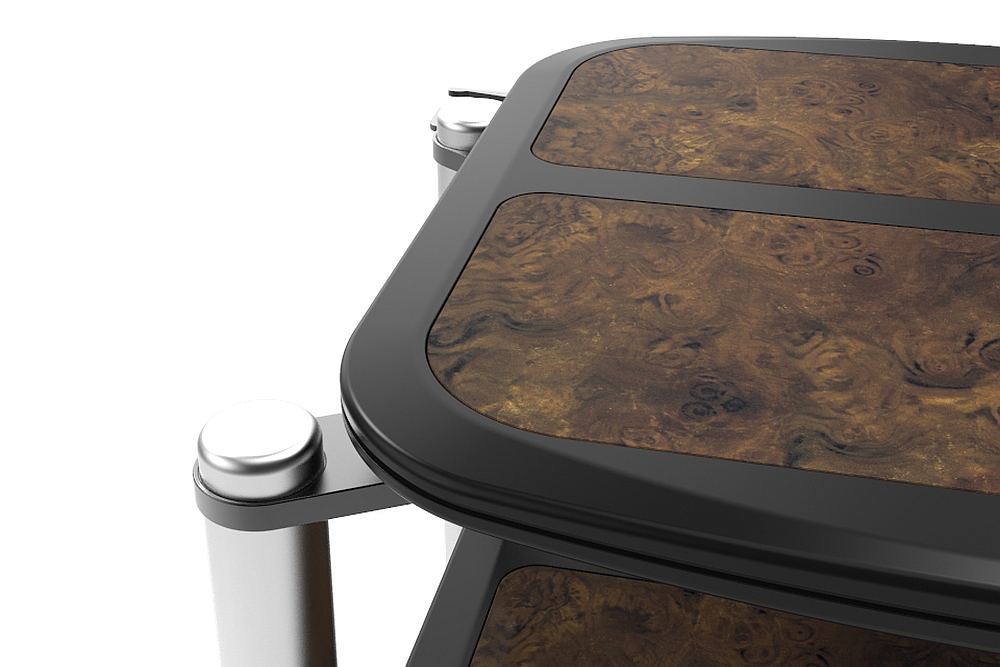
That hierarchical order has been my experience up to this point. And that was my expectation too, during the setup of the Statement rack and prior to firing the system. But boy, I’d be darned… this superbly-engineered rack certainly motivated a recalibration of my preconceived notions. What I heard with intimately familiar recordings was along the lines of a cable change; of the “substantial differences” variety too. Crickey!
Yet, the influence the Model V Statement racks awarded the system’s performance were far more evident to me when playing subtle, delicate music like Jazz ensembles, Chamber music, etc.. While the improvements were, of course, there on the more raucous genres too, they were less noticeable than on music that features the low level detail inherent in the intricate interplay between acoustic instruments, or the singing oscillations of a beautiful vocalist, or the gentle finger picking of a string.
The subtle harmonic textural relationships on the diverse instruments on “Nihavent” from Joël Grare’s wonderfully produced Paris, Istanbul, Shanghai CD – a harmonious musical convergence of those three very different cultures – were given an extra level of enrichment from the overall floor of low level musical data. Subtly, there seemed to be more detail articulation and timbrel truth with gains in rhythm too.
Also improved were spatial cues where the positioning of images seemed slightly more in focus. I use several recordings where gifted musicians, playing acoustic instruments, have been either captured at a well-recorded live concert or within the context of a ‘live’ performance in a studio or dedicated space. With the SGR Audio Statement rack providing the system’s support, I was able to more easily make out where performers were standing in relation to each other and the soundfield. I found myself having to use less concentration which makes for an overall more complete and enjoyable experience. Guitar maestro Luc was further apart and slightly further behind in a deeper soundstage from maestro Lagrène in the duo’s excellent Duet title, for example.
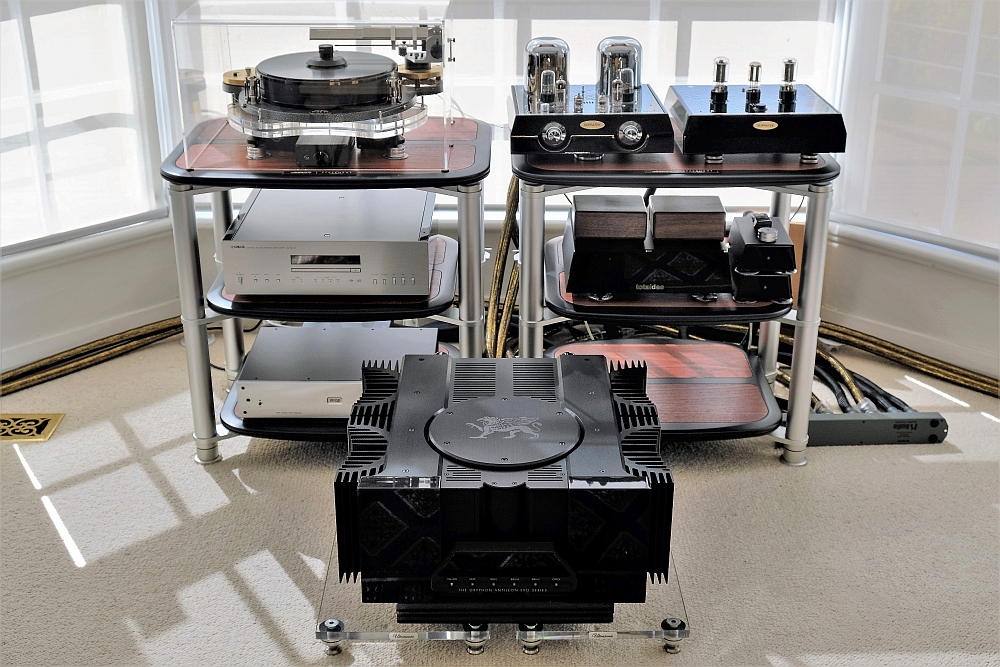
Equal soundscape accuracy was shown in the brilliant The Joy Of album from Australia’s FourPlay (not to be confused with the light Jazz Fourplay from America) where the quartet’s cellos, violas and violins showed stunning low level transients and detail. On track 2, a cover of Sinéad O’Connor’s “Just Like U Said It Would B” was potently dynamic, thoroughly detailed and spookily present. Here, I also noticed an improvement on the leading edge of the notes, a sense of improved initial attack.
Conclusion
The role of a quality Hi-Fi rack system should be to provide support and a form of isolation and/or coupling to combat vibrational distortions in order to allow the full potential of your components to shine. In the case of the new SGR Audio Model V Statement racking system, the above mandate has been met to the highest degree. The additive elements of six isolation techniques, most importantly the viscoelastic decoupling, the Corian ‘Energy Sink Isolation Pads’ inserts and the superbly solid machined aluminium supports, in my opinion, have proven themselves to provide worthwhile sonic improvements over the excellent last-gen flagship rack (and every other rack I’ve had in-house, for that matter). Sonically, of particular importance are the exactness in terms of low level detail, the gains in tonal and textural nuance and the added precision in image density and placement.
The above is enough of a clincher in itself, should you be weighing your options when considering the purchase of a top-level racking system. But there’s so much more on offer with the Statement rack. It features solid engineering principles built into its design, it’s beautifully styled and finished (aspects which also apply to the company’s lower rung options), is offered in natural or black aluminium with attractive platform insert veneer options. It’s the result of fabrication with a fervent eye to detail. What’s more, it’s built in Australia by a company which is pulsing with increasing power and interest internationally.
The SGR Audio Model V Statement Hi-Fi racks are a winner of a design and the #0001s are now staying in situ as an essential component within the context of SoundStage! Australia HQ’s reference system.
… Edgar Kramer
This email address is being protected from spambots. You need JavaScript enabled to view it.
Associated Equipment
- Speakers — Wilson Audio Alexia Series 2, Axis Loudspeakers VoiceBox S (nearfield monitor), Vermouth Audio Little Luccas Mk.II
- Amplifier — Gryphon Audio Antileon EVO
- Preamplifier — Supratek Cortese, Lightspeed Attenuator LDR passive
- Sources — Digital: Yamaha CD-S2100 used as transport, Totaldac d1-core DAC, MacBook with BitPerfect software, AIFF files. Analogue: Michell Engineering Orbe with Gert Pedersen Level 3 modifications and Origin Live Ultra upgraded motor, Trans-Fi Terminator air bearing linear-tracking arm, Shelter Harmony cartridge, Supratek Cortese & REDGUM Audio RGPH2 phono stages
- Processor — DEQX PreMate
- Cables — sILENzIO loom, Vermouth Audio Black Pearl Mk.II loom
- Audio Rack — SGR Audio Statement Model V
- Miscellaneous — Les Davis Audio Viscoelastic CLD discs
SGR Audio Model V Statement Hi-Fi Equipment Rack
Price: AU$4200/level
Warranty: Five Years
Australian Distributor: SGR Audio
+61 3 9846 8002
www.sgrhifiracks.com
SGR Audio
11 Websters Road, Templestowe
VIC 3106 Australia
+61 3 9846 8002
www.sgraudio.com






